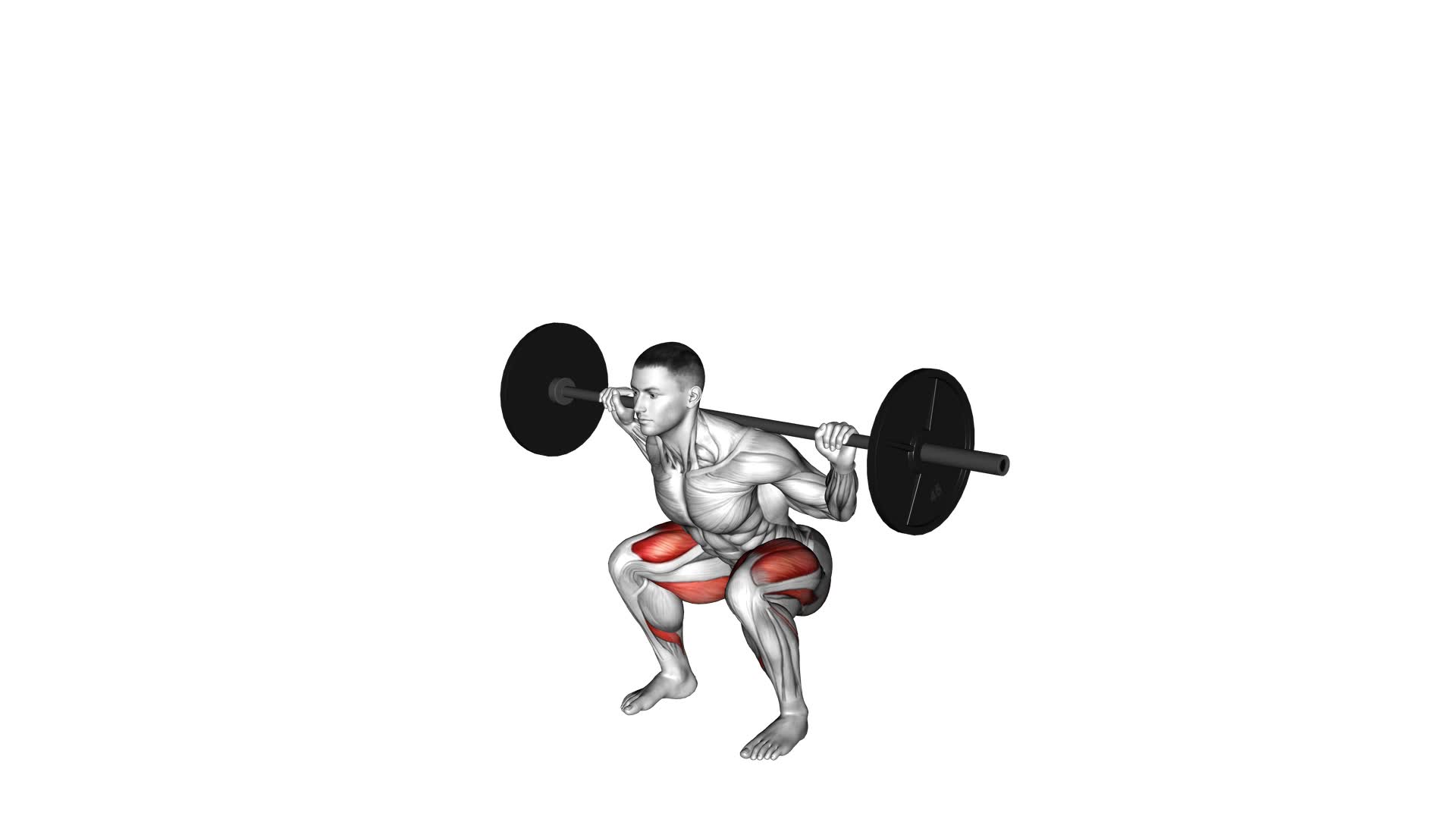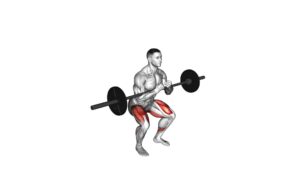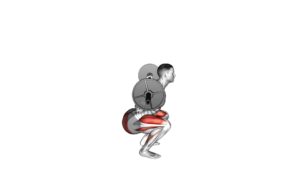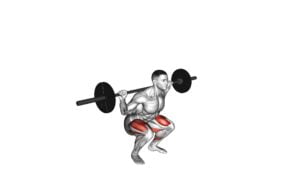Barbell Full Squat – Video Exercise Guide & Tips

Looking to perfect your barbell full squat form? This compound exercise is a powerhouse for creating strength in your legs, back and core. In this blog post, we’ll provide you with an easy-to-follow guide on how to perform a barbell full squat correctly, complete with video demonstrations and helpful tips.
Watch This Exercise Video
Get ready to see muscle growth like never before!
Key Takeaways
- The barbell full squat is a compound exercise that targets multiple muscle groups in the lower body, including the quadriceps, hamstrings, and glutes.
- Proper form is crucial for maximizing results and preventing injuries during the barbell full squat. This includes maintaining a shoulder-width stance, creating whole body tension, controlling your descent, and maintaining proper depth and knee positioning.
- Assistance moves such as the front squat, goblet squat, split squat, and Bulgarian split squat can help improve your performance in the barbell full squat by targeting specific muscle groups and improving overall technique.
- To achieve new personal records in your back squat, gradually increase weight over time, vary rep ranges and sets to stimulate muscle growth, and prioritize rest and recovery between training sessions.
Overview of the Barbell Full Squat
The Barbell Full Squat is a staple in strength and resistance training, targeting several muscle groups for a comprehensive lower body workout. As one of the classic Weightlifting exercises, this full squat technique involves balancing a weighted barbell on your traps while performing squat movements – flexing and extending the knees.
It’s essential to maintain proper form throughout this exercise not only to achieve maximum results but also to prevent injuries.
This dynamic exercise engages primary muscles like the quadriceps, hamstrings, glutes along with secondary stabilizer muscles such as abs, calves and lower back; making it ideal for those seeking growth in easy steps via compound exercises.
The feet shoulder-width apart stance helps distribute weight evenly ensuring stability during each repetition. Be it novice lifters getting acquainted with Squats for beginners or advanced trainers aiming at breaking their Back squat PR (Personal Record), mastering this barbell full squat technique can be transformative to anyone’s fitness journey.
How to Perform a Barbell Full Squat
To perform a Barbell Full Squat, start by standing with your feet shoulder-width apart and the weighted barbell resting on your upper back.
Stance and Hand Placement
For the barbell full squat, proper stance and hand placement are crucial for maintaining balance and maximizing strength. Start by positioning your feet shoulder-width apart, with toes slightly turned outwards.
This stance provides a stable base and allows for optimal engagement of the muscles in your lower body. As for your hands, place them on the barbell just outside of shoulder width.
Your grip should be firm but not overly tight to ensure control throughout the exercise. By establishing the right stance and hand placement, you set yourself up for success in performing the barbell full squat with correct form and maximum results.
Creating Whole Body Tension
To maximize your performance and protect your body during the barbell full squat, it’s crucial to create whole body tension. This means engaging all of your muscles and maintaining a tight, stable position throughout the movement.
Start by gripping the bar tightly with your hands and pulling your shoulder blades back to activate your upper back muscles. Next, brace your core by squeezing your abs as if someone was about to punch you in the stomach.
Finally, squeeze your glutes and quads to generate power from the lower body. By creating whole body tension, you’ll be able to maintain proper form and lift heavier weights safely.
Controlling Your Descent
To perform a barbell full squat effectively, it is important to have control during the descent. As you lower your body down, focus on maintaining a slow and controlled movement. This will help engage and activate the muscles in your legs, hips, and core more effectively.
Avoid rushing through this part of the exercise as it can lead to loss of balance or improper form. By controlling your descent, you are able to maximize the benefits of the barbell full squat and build greater lower body strength over time.
Proper Depth and Knee Positioning
Maintaining proper depth and knee positioning is crucial for a successful barbell full squat. As you descend into the squat, aim to break parallel or go slightly below, ensuring that your thighs are parallel to the ground.
This deep position engages more muscles and maximizes your results. In terms of knee positioning, it’s important to keep them in line with your toes throughout the movement. Avoid letting your knees buckle inward or push too far forward over your toes, as this can put unnecessary strain on the joints.
By maintaining proper depth and knee positioning, you’ll minimize the risk of injury and optimize the effectiveness of this exercise.
Ascending Out of the Hole
To ascend out of the hole in a barbell full squat, you need to engage your leg and hip muscles. Push through your heels as you straighten your legs, driving the weight upward. Keep your chest up and head facing forward throughout the movement.
Remember to breathe out as you exert force to help maintain stability and control. By focusing on proper form and using the strength from your lower body, you can successfully ascend out of the bottom position of the squat and maximize your results.
Tips for Proper Form on the Barbell Full Squat
Maintain good posture, with your chest up and head facing forward, throughout the entire movement.
Maintaining Good Posture
Maintaining good posture is crucial when performing a barbell full squat. Keep your chest up and head facing forward throughout the entire movement. This helps to align your spine and prevent any strain on your neck or lower back.
By maintaining proper posture, you not only enhance the effectiveness of the exercise but also reduce the risk of injury. So, focus on keeping your upper body tall and aligned while performing the barbell full squat for maximum results.
Foot and Hand Placement
To perform a barbell full squat with proper form and maximum results, foot and hand placement are crucial. Start by positioning your feet shoulder-width apart, with toes slightly turned out for stability.
Make sure your weight is evenly distributed across both feet. As for hand placement, grip the barbell just outside of shoulder width, using an overhand grip or a mixed grip if needed for added support.
By setting up your feet and hands correctly, you’ll be able to maintain balance and control throughout the entire squat movement while effectively targeting your lower body muscles.
Controlling the Descent
Controlling the descent is a crucial aspect of performing a barbell full squat with proper form. As you lower your body, focus on maintaining control and stability throughout the movement.
Keep your core engaged and avoid rushing through the descent. By controlling the speed at which you lower yourself, you can better engage the muscles in your legs and maintain balance.
Remember to keep your chest up and head facing forward as you descend so that you maintain proper form throughout the exercise. This will help maximize results and minimize the risk of injury during your workout session.
Breathing Techniques
Proper breathing techniques are an essential component of performing a barbell full squat with correct form and maximizing your results. When you take a breath in, focus on expanding your diaphragm and filling your lungs with air, creating intra-abdominal pressure that helps stabilize your core.
As you descend into the squat, exhale slowly through pursed lips to maintain tension throughout your body. This controlled breathing pattern helps you stay balanced and ensures that you’re using optimal technique during each repetition of the exercise.
By mastering these breathing techniques, you can enhance your performance and make the most out of this powerful lower-body workout.
Assistance Moves for Improving Barbell Full Squat Performance
Assistance moves such as the Front Squat, Goblet Squat, Split Squat, and Bulgarian Split Squat can help improve your Barbell Full Squat performance.
Front Squat
To perform a front squat, start by placing the barbell on the front of your shoulders, gripping it with your palms facing up. Keep your feet shoulder-width apart and descend into a squat position, making sure to maintain good posture with your chest up and head facing forward.
Control the descent and aim for proper depth by lowering until your thighs are parallel to the ground. Finally, push through your heels to ascend out of the squat position and return to standing.
The front squat is an effective assistance move for improving barbell full squat performance as it targets similar muscles while placing more emphasis on the quadriceps.
Goblet Squat
The goblet squat is a great assistance move to improve your barbell full squat performance. This exercise not only helps you strengthen your lower body, but it also improves your overall squat technique and form.
To do the goblet squat, hold a dumbbell or kettlebell vertically against your chest with both hands, close to your body. Stand with your feet shoulder-width apart and toes slightly pointed outward.
Keep your chest up and head facing forward as you lower yourself into a deep squat position, aiming to get your thighs parallel to the ground. Drive through your heels to return back up to the starting position.
Split Squat
To further improve your performance in the barbell full squat, incorporating assistance moves into your training routine is essential. One such move is the split squat. This exercise targets your lower body, specifically your quadriceps and glutes.
To perform a split squat, start by standing with one foot forward and the other foot positioned behind you. Slowly lower yourself down until both knees are at 90-degree angles, keeping your front knee aligned with your ankle and ensuring that your back knee comes close to or touches the ground.
Once at the bottom of the movement, push through your front heel to return to a standing position. Adding split squats to your workout routine will not only help you build leg strength but also improve stability and balance for an overall more effective barbell full squat.
Bulgarian Split Squat
To further improve your performance in the barbell full squat, you can incorporate the Bulgarian split squat into your training routine. This exercise helps to target and strengthen the muscles of your legs individually.
To perform a Bulgarian split squat, start by placing one foot forward and the other foot elevated behind you on a bench or step. Keep your torso upright and descend into a lunge position until your front thigh is parallel to the ground.
Push through your front heel to return to starting position. Repeat for desired reps before switching sides.
How to Achieve a New Back Squat Personal Record (PR)
Learn the tips and steps to achieve a new back squat personal record, taking your strength and performance to the next level.
Tips for Progression
To progress in your barbell full squats and achieve new personal records (PRs), there are a few key tips to keep in mind. First, gradually increase the weight you’re lifting over time.
Start with a weight that challenges you but allows for proper form, then add small increments each week to continue challenging your muscles. Secondly, vary your rep ranges and sets to continually push yourself.
Mix up heavy sets with lower reps and lighter sets with higher reps to stimulate muscle growth and prevent plateaus. Lastly, don’t forget about rest and recovery. Give your body time to recover between squat sessions so that you can perform at your best on training days.
Different Weight Goals (1x, 1.5x, 2x bodyweight)
Achieving different weight goals in the barbell full squat is a great way to challenge yourself and track your progress. Setting weight goals of 1x, 1.5x, or even 2x your bodyweight can help you push your limits and continuously improve your strength.
Whether you’re a beginner or experienced lifter, these weight goals provide clear targets to work towards and keep you motivated during your training sessions. Remember to gradually increase the load over time and always prioritize proper form to prevent injuries while working towards these milestones.
Conclusion
Mastering the barbell full squat is a key step towards maximizing your leg strength and achieving impressive results in your lower body workout. By following the proper form and technique outlined in the video exercise guide, you can ensure maximum gains and minimize the risk of injury.
Incorporating assistance exercises like the front squat and goblet squat can further enhance your performance, while setting new personal records will keep you motivated to reach even higher goals.
So grab that weighted barbell, perfect your squat technique, and take your fitness journey to new heights!
FAQs
1. What is a Barbell Full Squat?
A Barbell Full Squat is a strength training exercise that works various muscles and involves performing squats with a barbell positioned on your back.
2. How to perform a barbell squat for beginners?
For beginners, start off by standing feet shoulder-width apart with the barbell on your back, then gradually lower yourself through knee flexion until your thighs are parallel to the floor.
3. What muscles does the barbell squat work?
The barbell full squat mainly targets glutes, quadriceps and hamstrings but also engages other supportive muscle groups in both lower and upper body areas.
4. Can I do squats with dumbbells instead of a barbell?
Yes! Dumbbells can substitute for Barbells offering similar benefits while providing an added challenge to balance control during your fitness routine
5. Where can I find exercise videos or guides for doing proper squats?
There are dedicated video exercise guides & tips available online that precisely demonstrate how to maintain correct form during every phase of the Barbell Full Squat.

Author
Years ago, the spark of my life’s passion ignited in my mind the moment I stepped into the local gym for the first time. The inaugural bead of perspiration, the initial endeavor, the very first surge of endorphins, and a sense of pride that washed over me post-workout marked the beginning of my deep-seated interest in strength sports, fitness, and sports nutrition. This very curiosity blossomed rapidly into a profound fascination, propelling me to earn a Master’s degree in Physical Education from the Academy of Physical Education in Krakow, followed by a Sports Manager diploma from the Jagiellonian University. My journey of growth led me to gain more specialized qualifications, such as being a certified personal trainer with a focus on sports dietetics, a lifeguard, and an instructor for wellness and corrective gymnastics. Theoretical knowledge paired seamlessly with practical experience, reinforcing my belief that the transformation of individuals under my guidance was also a reflection of my personal growth. This belief holds true even today. Each day, I strive to push the boundaries and explore new realms. These realms gently elevate me to greater heights. The unique combination of passion for my field and the continuous quest for growth fuels my drive to break new ground.







